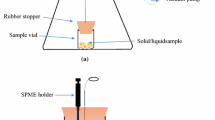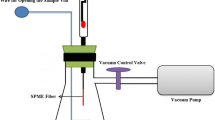Abstract
This research introduces a novel solid-phase microextraction technology, in which the features of heating of sample, cooling of sorbent, and extraction under vacuum condition have been merged. Heating-, cooling- and vacuum-assisted solid-phase microextraction (HCV-SPME) method was developed as an efficient solution for the direct extraction of volatile and semi-volatiles species in complex solid samples. HCV-SPME was coupled with an in-needle capillary adsorption trap (HCV-INCAT) and applied to the direct extraction of polycyclic aromatic hydrocarbons (PAHs) within soil samples. It consisted of polythiophene/carboxylic acid modified multi-walled carbon nanotube nanocomposite, which was synthesized and wall-coated within a platinized stainless-steel needle via electropolymerization. The influential experimental variables (desorption conditions, sample temperature, adsorption temperature, sampling flow rate, and vacuum level) on the extraction efficiency were optimized. The developed HCV-INCAT technique was used in conjunction with GC-FID and applied for the extraction and determination of PAHs in contaminated soil samples, closely matching with those obtained using a validated ultrasonic-assisted solvent extraction procedure. Under the optimal conditions, linear dynamic ranges, limits of detection, and relative standard deviations were obtained 0.007–5 µg g−1, 8–20 pg g−1, and 7.1–12.1%, respectively, for direct extraction of naphthalene, fluorene, phenanthrene, fluoranthene, and pyrene from solid samples.





Similar content being viewed by others
References
Jalili V, Barkhordari A, Ghiasvand A (2020) A comprehensive look at solid-phase microextraction technique: a review of reviews. Microchem J 152:104319. https://doi.org/10.1016/j.microc.2019.104319
Bagheri H, Babanezhad E, Khalilian F (2009) An interior needle electropolymerized pyrrole-based coating for headspace solid-phase dynamic extraction. Anal Chim Acta 634:209–214. https://doi.org/10.1016/j.aca.2008.12.047
Heidari N, Ghiasvand A, Abdolhosseini S (2017) Amino-silica/graphene oxide nanocomposite coated cotton as an efficient sorbent for needle trap device. Anal Chim Acta 975:11–19. https://doi.org/10.1016/j.aca.2017.04.031
Kędziora K, Wasiak W (2017) Extraction media used in needle trap devices-progress in development and application. J Chromatogr A 1505:1–17. https://doi.org/10.1016/j.chroma.2017.05.030
Heidari N, Ghiasvand A (2019) A review on magnetic field-assisted solid-phase microextraction techniques. J Liq Chromatogr Relat Technol. https://doi.org/10.1080/10826076.2019.1668804
McComb ME, Oleschuk RD, Giller E, Gesser HD (1997) Microextraction of volatile organic compounds using the inside needle capillary adsorption trap (INCAT) device. Talanta 44:2137–2143. https://doi.org/10.1016/S0039-9140(97)00093-3
Ghiasvand AR, Yazdankhah F (2017) Single-step reinforced microextraction of polycyclic aromatic hydrocarbons from soil samples using an inside needle capillary adsorption trap with electropolymerized aniline/multi-walled carbon nanotube sorbent. J Chromatogr A 1487:47–53. https://doi.org/10.1016/j.chroma.2017.01.056
Jalili V, Barkhordari A, Ghiasvand A (2020) New extraction media in microextraction techniques. A review of reviews. Microchem J 153:104386. https://doi.org/10.1016/j.microc.2019.104386
Jalili V, Barkhordari A, Ghiasvand A (2019) New extraction media in microextraction techniques. A review of reviews. Microchem J. https://doi.org/10.1016/j.microc.2019.104386
Ghiasvand A, Behfar M, Yazdankhah F (2019) Reduced-pressure fiber-in-needle sampling of aldehydes for room temperature assessment of edible oils’ oxidative stability. Chromatographia 82:1405–1414. https://doi.org/10.1007/s10337-019-03752-7
Senthilkumar B, Thenamirtham P, Selvan RK (2011) Structural and electrochemical properties of polythiophene. Appl Surf Sci 257:9063–9067. https://doi.org/10.1016/j.apsusc.2011.05.100
Hinds BJ, Chopra N, Rantell T, Andrews R, Gavalas V, Bachas LG (2004) Aligned multiwalled carbon nanotube membranes. Science 303:62–65. https://doi.org/10.1126/science.1092048
Chang Y-H, Wu M-S, Lin K-F (2014) Graphting polyimide to MWCNT for enhancing dispersion and properties of MWCNT/polyetherimide nanocomposites. J Polym Res 21:419. https://doi.org/10.1007/s10965-014-0419-2
Abdolhosseini S, Ghiasvand A, Heidari N (2017) A high area, porous and resistant platinized stainless steel fiber coated by nanostructured polypyrrole for direct HS-SPME of nicotine in biological samples prior to GC-FID quantification. J Chromatogr B 1061:5–10. https://doi.org/10.1016/j.jchromb.2017.06.042
Ghiasvand AR, Hajipour S, Heidari N (2016) Cooling-assisted microextraction: comparison of techniques and applications. Trends Anal Chem 77:54–65. https://doi.org/10.1016/j.trac.2015.12.008
Ghiasvand AR, Pirdadeh-Beiranvand M (2015) Cooling/heating-assisted headspace solid-phase microextraction of polycyclic aromatic hydrocarbons from contaminated soils. Anal Chim Acta 900:56–66. https://doi.org/10.1016/j.aca.2015.10.016
Brunton N, Cronin D, Monahan F (2001) The effects of temperature and pressure on the performance of Carboxen/PDMS fibres during solid phase microextraction (SPME) of headspace volatiles from cooked and raw turkey breast. Flavour Fragr J 16:294–302. https://doi.org/10.1002/ffj.1000
Psillakis E, Yiantzi E, Kalogerakis N (2013) Downsizing vacuum-assisted headspace solid phase microextraction. J Chromatogr A 1300:119–126. https://doi.org/10.1016/j.chroma.2013.02.009
Banjoo DR, Nelson PK (2005) Improved ultrasonic extraction procedure for the determination of polycyclic aromatic hydrocarbons in sediments. J Chromatogr A 1066:9–18. https://doi.org/10.1016/j.chroma.2005.01.033
Gupta TK, Singh BP, Dhakate SR, Singh VN, Mathur RB (2013) Improved nanoindentation and microwave shielding properties of modified MWCNT reinforced polyurethane composites. J Mater Chem A 1:9138–9149. https://doi.org/10.1039/C3TA11611E
Ghiasvand A, Dowlatshah S, Nouraei N, Heidari N, Yazdankhah F (2015) A solid-phase microextraction platinized stainless steel fiber coated with a multiwalled carbon nanotube-polyaniline nanocomposite film for the extraction of thymol and carvacrol in medicinal plants and honey. J Chromatogr A 1406:87–93. https://doi.org/10.1016/j.chroma.2015.06.052
Zhang H, Hu Z, Li M, Hu L, Jiao S (2014) A high-performance supercapacitor based on a polythiophene/multiwalled carbon nanotube composite by electropolymerization in an ionic liquid microemulsion. J Mater Chem 2:17024–17030. https://doi.org/10.1039/C4TA03369H
Fu C, Zhou H, Liu R, Huang Z, Chen J, Kuang Y (2012) Supercapacitor based on electropolymerized polythiophene and multi-walled carbon nanotubes composites. Mater Chem Phys 132:596–600. https://doi.org/10.1016/j.matchemphys.2011.11.074
Sun F, Littlejohn D, David Gibson M (1998) Ultrasonication extraction and solid phase extraction clean-up for determination of US EPA 16 priority pollutant polycyclic aromatic hydrocarbons in soils by reversed-phase liquid chromatography with ultraviolet absorption detection. Anal Chim Acta 364:1–11. https://doi.org/10.1016/S0003-2670(98)00186-X
Beiranvand M, Ghiasvand A (2017) Simple, low-cost and reliable device for vacuum-assisted headspace solid-phase microextraction of volatile and semivolatile compounds from complex solid samples. Chromatographia 80:1771–1780. https://doi.org/10.1007/s10337-017-3422-z
Zhang Z, Pawliszyn J (1993) Headspace solid-phase microextraction. Anal Chem 65:1843–1852. https://doi.org/10.1021/ac00062a008
Ghiasvand A, Zarghami F, Beiranvand M (2018) Ultrasensitive direct determination of BTEX in polluted soils using a simple and novel pressure-controlled solid-phase microextraction setup. J Iran Chem Soc 15:1051–1059. https://doi.org/10.1007/s13738-018-1302-6
Wang X, Liu Y, Tao S, Xing B (2010) Relative importance of multiple mechanisms in sorption of organic compounds by multiwalled carbon nanotubes. Carbon 48:3721–3728. https://doi.org/10.1016/j.carbon.2010.06.034
Gholivand MB, Abolghasemi MM (2012) Inside needle capillary adsorption trap device for headspace solid-phase dynamic extraction based on polyaniline/hexagonally ordered silica nanocomposite. J Sep Sci 35:695–701. https://doi.org/10.1002/jssc.201100836
Ghiasvand AR, Hosseinzadeh S, Pawliszyn J (2006) New cold-fiber headspace solid-phase microextraction device for quantitative extraction of polycyclic aromatic hydrocarbons in sediment. J Chromatogr A 1124:35–42. https://doi.org/10.1016/j.chroma.2006.04.088
Gholivand MB, Abolghasemi MM, Fattahpour P (2011) Polypyrrole/hexagonally ordered silica nanocomposite as a novel fiber coating for solid-phase microextraction. Anal Chim Acta 704:174–179. https://doi.org/10.1016/j.aca.2011.07.045
Ghiasvand A, Heidari N, Abdolhosseini S, Hamdi A, Haddad P (2018) Evaluation of a cooling/heating-assisted microextraction instrument using a needle trap device packed with aminosilica/graphene oxide nanocomposites, covalently attached to cotton. Analyst 143:2632–2640. https://doi.org/10.1039/C8AN00063H
Acknowledgements
The authors sincerely acknowledge Lorestan University for supporting this research. The authors acknowledge Reza Givehkesh, electronic technician, for his technical support to fabricate some parts of the setup.
Funding
This study was not funded by any grants.
Author information
Authors and Affiliations
Corresponding author
Ethics declarations
Conflict of interest
The authors have no conflict of interest to declare.
Ethical approval
This article does not contain any studies with human participants or animals performed by any of the authors.
Additional information
Publisher's Note
Springer Nature remains neutral with regard to jurisdictional claims in published maps and institutional affiliations.
Electronic supplementary material
Below is the link to the electronic supplementary material.
Rights and permissions
About this article
Cite this article
Ghiasvand, A., Yazdankhah, F. & Paull, B. Heating-, Cooling- and Vacuum-Assisted Solid-Phase Microextraction (HCV-SPME) for Efficient Sampling of Environmental Pollutants in Complex Matrices. Chromatographia 83, 531–540 (2020). https://doi.org/10.1007/s10337-020-03869-0
Received:
Revised:
Accepted:
Published:
Issue Date:
DOI: https://doi.org/10.1007/s10337-020-03869-0




